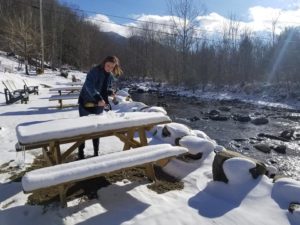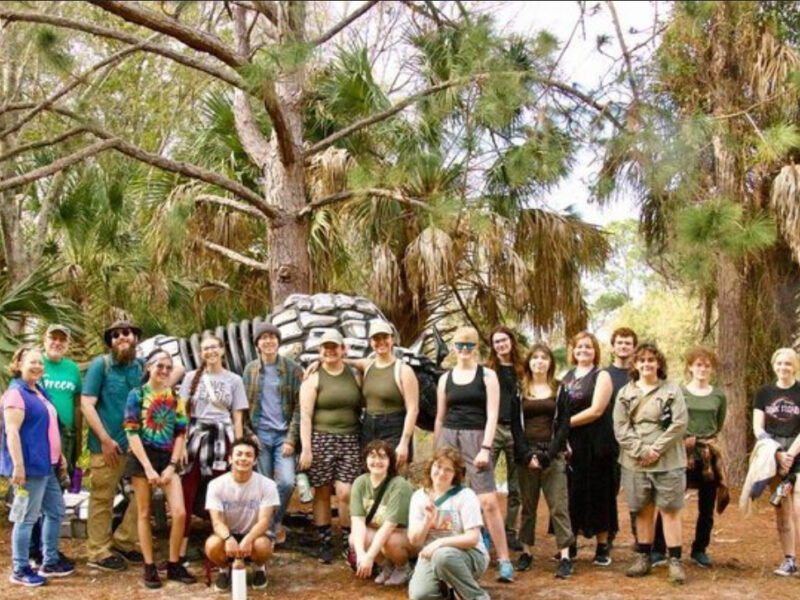Above photo: Grandfather Vineyard and Winery is a quaint winery at the base of Grandfather Mountain in North Carolina. Courtesy of Jordan Prince
By Whitney Elfstrom
Spring break is a time for college students to head as far south as possible. Cancun is overflowing with body shots and foot-long margaritas – but that’s not really my scene.
Living in Central Florida, I have all summer to hit the beach, and most of fall and winter too. The move for me has always been to go north or out west, and this year was no different.
My roommate Jordan and I drove to visit my aunt and uncle in Banner Elk, North Carolina where we were met with a foot of snow and 19 degree weather.
As two longtime Floridians, it’s safe to assume that we were unprepared and under packed for the weather. Luckily layers exist, and they were taken advantage of. I’m talking the little brother from “A Christmas Story” level.

The weather meant that many of our outside plans were squashed and instead we spent most of our time at Grandfather Valley & Winery – but we’re not going to complain about drinking red wine in a snow-covered cabin.
There were moments of trying to venture off into the cold for a change of destination. We tried to drink wine on the side of Beech Mountain at sunset, but after not being able to withstand five minutes outside those dreams died.
On the penultimate day of the trip the winter weather broke, and we were met with 60 degree temperatures and sunshine.
The snow had come and gone within a 36-hour period and clear skies signaling it was time to dangle from the side of Grandfather Mountain – also known as zip lining. The only problem was that blue skies didn’t mean the wind had stopped.
Zip lining was canceled.
Instead we hit Linville Caverns, a tourist destination for visitors to explore the inside of Humpback Mountain.
If we couldn’t soar over the mountains at least we could dwell beneath them, right?
As we waited for the tour to begin Jordan pointed out that the surrounding area held an eerie resemblance to The Haunted Mansion ride at Walt Disney World, but something told me the scariest thing we might bump into were a few bats.
We filed into the cavern in a single file line, and the temperature instantly dropped to 52 degrees. Water dripped from the ceiling and covered the cavern floor. Dim lights were hidden within the small crevices of the walls.
We definitely weren’t in Disney, but we were in the closest thing western North Carolina has to a theme park.
Our peppy tour guide with red and green striped hair, Amy, led us through the cavern dropping facts about the cave, which were often followed up by rock puns. The biggest rule was “don’t touch the rocks.” Linville Caverns is one of the few remaining active caverns, which means the the oils from visitor’s hands had the ability to cause damage and inhibit future growth.
Linville Caverns opened its doors to the public in 1937, but it was discovered in 1822 by a fishing expedition led by Henry E. Colton after the fishermen saw trout swimming in and out of solid rock. Drawn to the odd sight, the men followed the fish and found a small opening that led them into the cavern.
We wandered through the living cave and were careful not to slam our heads into any protruding rocks because, according to Amy, as soon as one person hit their head it would turn into a ripple effect, and no one wanted that.
Amy tossed out facts about the coloration of the rocks and the population of bats hidden among the ceiling. Green rocks were covered in algae and moss while red showed signs of iron oxidation.
As for the bat population, what was once a thriving community has now decreased to one sole, two-inch bat that dwelled within the cave. This was due to a disease called White-Nose Syndrome, a fungus that attacks hibernating bats.
Finally we entered the only place in the cavern in which visitors were allowed to touch the walls – in fact it was encouraged. This was an effort to keep the sliver of space from closing in; however, those with claustrophobia were advised to stay back.
There we stood above a bottomless pool of water and legend has it that someone once hung a 250 foot rope into it, and it still didn’t reach the bottom. We all held onto our wifi-less phones closely because what was dropped would never be found again.
The tour came to an end with a demonstration of absolute darkness, something that can only be seen in the back of a cave or the abyss of the ocean. The lights went out. I looked to my left and to my right – nothing. I held my hand inches from my face and again, nothing.
Amy said that after six months of complete darkness a person would go completely blind, but by then it wouldn’t have matter because the person would have already been insane for three months, and I could see why. Luckily after a minute or two we were brought back into the light and freed from impending insanity.
As the tour came to an end Amy shared another Linville legend, apparently the mineral rich water that had been dripping from the ceiling and onto our heads was a “kiss from the cave” that would leave us with three days of good luck or crystallized hair that she called “dread rocks” if we forgot to wash it out.



